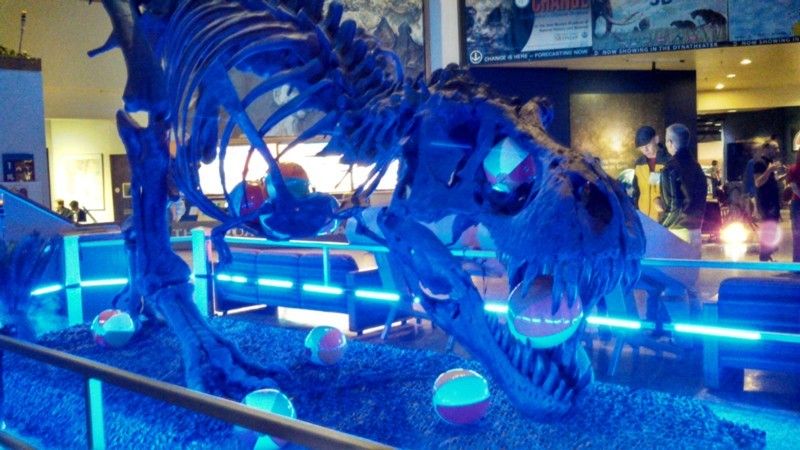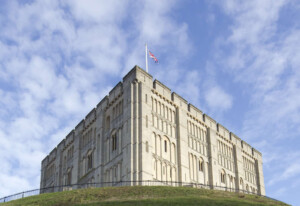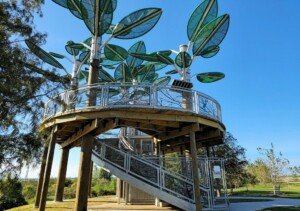Albuquerque, New Mexico, best known for its Balloon Festival and as the home of the hit series Breaking Bad, recently played host to the 2013 Association of Science – Technology Centers (ASTC) annual conference. 
Over four days, nearly 2, 000 attendees enjoyed over 100 educational sessions, numerous cutting edge product demonstrations, a sold-out exhibit hall and lively evening receptions.
By Clara Rice, Jack Rouse Associates.
Founded in 1973, and comprised of 650 institutions in nearly 50 countries, ASTC aims to further public engagement with science and to serve as a conduit for its members, advancing their common goals. According to its President and CEO, Bud Rock, (below left) ASTC “wants science centers to be strong in their communities. Science  centers should be considered essential because of their role in science learning, so we strive for them to be relevant, innovative and inspirational.” While ASTC is headquartered in Washington, DC, the organization has an extensive global reach. “The way we are viewed globally is the way we are viewed locally, ” said Rock.
centers should be considered essential because of their role in science learning, so we strive for them to be relevant, innovative and inspirational.” While ASTC is headquartered in Washington, DC, the organization has an extensive global reach. “The way we are viewed globally is the way we are viewed locally, ” said Rock.
The non-profit association offers capacity building and professional support to establish science centers all over the world, while providing science center professionals valuable skills that they can take back to their home countries. ASTC also speaks on behalf of science centers and public engagement in science worldwide, and is represented at the United Nations and at regional organizations around the globe. “The aim is to communicate everywhere for important scientific issues, ” Rock said.
ASTC created its conference nearly forty years ago to bring this diverse constituency together, and this year’s event addressed a universal slate of topics. The proceedings kicked off with an opening address and keynote presentation. Jim Walther of the National Museum of Nuclear Science and History, Joe Hastings of Explora, and Charlie Walter of the New Mexico Museum of Natural History and Science gave a triumvirate greeting, marking the first time the conference had enjoyed three distinct yet collaborative hosts.

Mayor Richard Berry welcomed the crowd to Albuquerque before handing the microphone over to Rock, who briefed the audience on several of ASTC’s key collaborations and initiatives. In a partnership with Discovery’s Science Channel, member museums will be able to access, via a subscription agreement, new Science Channel programs before they are available to the general public. ASTC is also joining forces with the US Department of Agriculture (USDA) to better examine the interplay of the general and agricultural sciences. Internationally, the ASTC is collaborating with the Organization of American States to provide expertise for those Latin American countries seeking to advance science education through museums and science centers.
Following Rock’s introduction, Eugenie C. Scott, D. Sc., (below) Executive Director of the National Center for Science Education, presented a keynote address on the  challenges facing museums and science centers from the Creationist and Intelligent Design movements. Warning the crowd that they’ve got “some competition of a type that you might not necessarily embrace, ” she spoke of the proliferation of Creationist museums and guidebooks created to ensure their members “will not be misled by evolutionist propaganda.”
challenges facing museums and science centers from the Creationist and Intelligent Design movements. Warning the crowd that they’ve got “some competition of a type that you might not necessarily embrace, ” she spoke of the proliferation of Creationist museums and guidebooks created to ensure their members “will not be misled by evolutionist propaganda.”
While most of the student visitors to Creationist museums are home-schooled or educated at private Christian schools, according to Scott, these institutions “nonetheless educate a lot of Americans, so there are a lot of our fellow citizens that are being taught scientifically erroneous information, and this obviously has consequences in terms of the science literacy of our fellow citizens.”
Scott introduced what she called the Three Pillars of Creationism, which have been the basis of a number of lawsuits waged by Creationists on museums, science centers and other learning institutions. They include:
1) Evolution is a “theory in crisis”.
2) Evolution and faith are incompatible.
3) Teachers should teach both evolution and Creationist theory to avoid dogma and encourage critical thinking.
 Scott was particularly passionate in addressing the third pillar, which she felt was the most pervasive and destructive: “It’s not a dogmatic process whatsoever, ” she asserted. “There’s a very large literature out there…that shows why the scientific claims of creation science or intelligent design are inaccurate, are not representative of good science, and are simply just wrong, so they should not be taught in schools. They have not earned the right to be presented in your museums.” She urged those institutions in the audience to “kick it up to the scientists” when faced with Creationist criticism: “you are interpreters of science, not producers of science.” The burden of proof, she argued, is on those challenging the consensus view of science.
Scott was particularly passionate in addressing the third pillar, which she felt was the most pervasive and destructive: “It’s not a dogmatic process whatsoever, ” she asserted. “There’s a very large literature out there…that shows why the scientific claims of creation science or intelligent design are inaccurate, are not representative of good science, and are simply just wrong, so they should not be taught in schools. They have not earned the right to be presented in your museums.” She urged those institutions in the audience to “kick it up to the scientists” when faced with Creationist criticism: “you are interpreters of science, not producers of science.” The burden of proof, she argued, is on those challenging the consensus view of science.
Following Scott’s enlightening keynote, the doors of the ballroom were flung open to reveal the Mariachi Nuevo Sonido band, which led the attendees down to the Exhibit Hall’s ribbon-cutting. A menu of twenty educational sessions followed, offering valuable insights on such topics as programming, fundraising, technology and human resources management. The day closed with a festive trifecta of celebrations at the three host museums, from free tours of Titanic: The Exhibition at the Museum of Natural History and Science, to a Breaking Bad-themed tent (complete with Walter White photo opp) sponsored by the Museum of Nuclear Science and History, to a lab/bar offering a variety of curious concoctions at Explora.
 While the Duke City Marathon runners galloped through the streets outside the Convention Center on Sunday, those inside enjoyed a morning keynote featuring Ramu Damodaran, Deputy Director for Partnership and Public Engagement at the United Nations’ Outreach Division. Damodaran (left) spoke about the need for an intersection between science and sustainability, as the UN’s focus shifts from “globalization” to “people-ization”.
While the Duke City Marathon runners galloped through the streets outside the Convention Center on Sunday, those inside enjoyed a morning keynote featuring Ramu Damodaran, Deputy Director for Partnership and Public Engagement at the United Nations’ Outreach Division. Damodaran (left) spoke about the need for an intersection between science and sustainability, as the UN’s focus shifts from “globalization” to “people-ization”.
A self-described “victim of acronyms”, Damodaran suggested an acronym for the ASTC that would be relevant to the UN’s current programs: “Achieving Sustainability Through Curiosity”. He pointed to the great challenges facing the world, from land degradation to water issues to nutrition, and looked to curiosity to cure these ills: “you come with a curiosity, and that curiosity can be taken back to transform not only your lives, but the lives of those around you.”
Damodoran even derived an acronym from the word “curious”: “Community, Unpredictability and Reason Is Our Understanding of Sustainability.” Regarding community, he asked museums to join the community of the United Nations, as it celebrates its 70th Anniversary. He also advised ASTC members to lean on the community of their organization. By adding the ASTC logo to their badges or tickets, their guests can feel as though they are part of a global movement. Regarding unpredictability, he urged museums to allow their visitors to be daring, unrestrained by rules. That being said, he cautioned that museums should be unpredictable based on reason, with a certain logic brought in before getting swept into experimentation.
By embracing curiosity and applying a reasoned unpredictably, museums and science centers can affect real change, not just in their institutions, but around the world: “Ultimately, a sustainable practice that is introduced in one part of the world is going to, with minor modifications, be applicable in another part. When you think of the UN as a large meta organization, ” Damodoran reasoned, “please also think that ultimately its achievements have to come down to the very basic ideas, discoveries and initiatives of the women, men and children who come to your [museums].”

The ASTC Conference’s remaining days overflowed with additional educational sessions, live demonstrations of the latest and greatest science center products and techniques, a Museum Open House Day with the three host organizations, a Big Screen Day highlighting 8 blockbuster 3D educational films, and a variety of digital planetarium demonstrations. According to Rock, even in light of the recent economic shutdown and increasing competition from technological diversions, engagement in the organization has been consistent over the last five years, with the 2013 conference being one of the highest attended ever. “Local communities have kept science centers alive because they realize their importance, ” said Rock.
As for what challenges the future may hold, Rock said that science centers need to network better amongst themselves, “the same way people do.” They also need to be adaptable so that if they experiment with a new technology or interactive, and it doesn’t work, they can shift gears quickly to better suit guests’ needs. Most of all, Rock acknowledged, science centers need to stay relevant: “guests don’t just want to be educated anymore. They want to be engaged and entertained. They need a total experience, so we need to continue to try and capture our audience.”
For more information on the Association of Science – Technology Centers, videos from the 2013 ASTC conference, and a preview of the 2014 conference in Raleigh, North Carolina, USA, please visit https://www.astc.org.

Images credits:
Dinosaur and Mariachi – Clara Rice. Explora – Explora. Bud Rock, Eugenie Scott, Ramu Domodaran – ASTC. Dinosaur Exhibit – New Mexico Museum of Natural History and Science.













